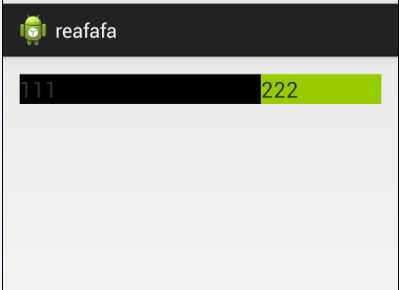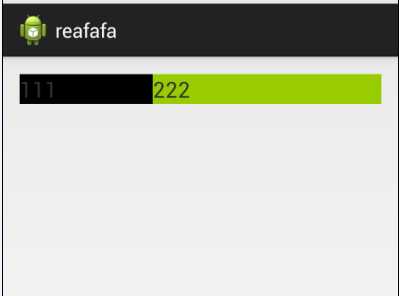首先声明只有在Linearlayout中,该属性才有效。之所以android:layout_weight会引起争议,是因为在设置该属性的同时,设置android:layout_width为wrap_content和match_parent会造成两种截然相反的效果。如下所示:
<LinearLayout
android:layout_width="match_parent"
android:layout_height="wrap_content"
android:orientation="horizontal" >
<TextView
android:layout_width="match_parent"
android:layout_height="wrap_content"
android:layout_weight="1"
android:background="@android:color/black"
android:text="111"
android:textSize="20sp" />
<TextView
android:layout_width="match_parent"
android:layout_height="wrap_content"
android:layout_weight="2"
android:background="@android:color/holo_green_light"
android:text="222"
android:textSize="20sp" />上面的布局将两个TextView的宽度均设为match_parent,一个权重为1,一个权重为2.得到效果如下:
可以看到权重为1的反而占了三分之二!
再看如下布局:
<LinearLayout
android:layout_width="match_parent"
android:layout_height="wrap_content"
android:orientation="horizontal" >
<TextView
android:layout_width="wrap_content"
android:layout_height="wrap_content"
android:layout_weight="1"
android:background="@android:color/black"
android:text="111"
android:textSize="20sp" />
<TextView
android:layout_width="wrap_content"
android:layout_height="wrap_content"
android:layout_weight="2"
android:background="@android:color/holo_green_light"
android:text="222"
android:textSize="20sp" />
</LinearLayout>即宽度为wrap_content,得到视图如下:
左边 TextView占比三分之一,又正常了。
android:layout_weight的真实含义是:一旦View设置了该属性(假设有效的情况下),那么该 View的宽度等于原有宽度(android:layout_width)加上剩余空间的占比!
设屏幕宽度为L,在两个view的宽度都为match_parent的情况下,原有宽度为L,两个的View的宽度都为L,那么剩余宽度为L-(L+L) = -L, 左边的View占比三分之一,所以总宽度是L+(-L)*1/3 = (2/3)L.事实上默认的View的weight这个值为0,一旦设置了这个值,那么所在view在绘制的时候执行onMeasure两次的原因就在这。
Google官方推荐,当使用weight属性时,将width设为0dip即可,效果跟设成wrap_content是一样的。这样weight就可以理解为占比了!
今天的文章android:layout_weight的真实含义分享到此就结束了,感谢您的阅读。
版权声明:本文内容由互联网用户自发贡献,该文观点仅代表作者本人。本站仅提供信息存储空间服务,不拥有所有权,不承担相关法律责任。如发现本站有涉嫌侵权/违法违规的内容, 请发送邮件至 举报,一经查实,本站将立刻删除。
如需转载请保留出处:https://bianchenghao.cn/13035.html


